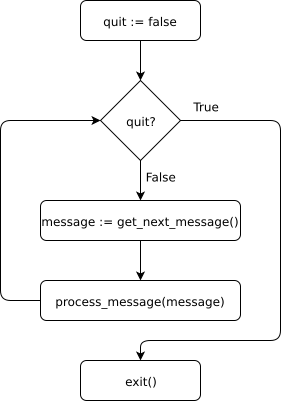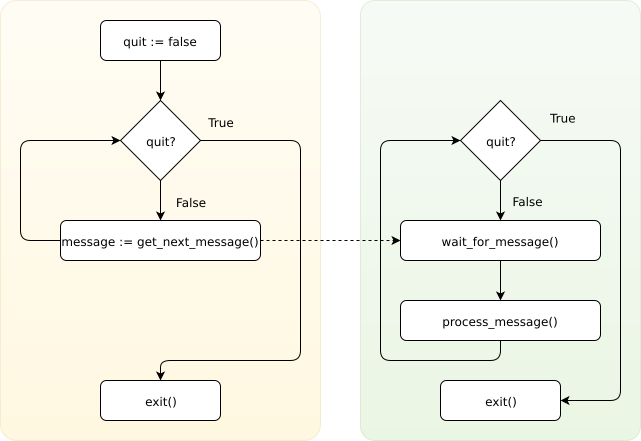The images are referenced from '../images/' but the document is two layers deep thus '../../images' needs to be used Signed-off-by: Peter Krempa <pkrempa@redhat.com> Reviewed-by: Daniel P. Berrangé <berrange@redhat.com>
3.5 KiB
Libvirt's event loop
This page describes the event loop approach used in libvirt. Both server and client.
Event driven programming
Traditionally, a program simply ran once, then terminated. This type of program was very common in the early days of computing, and lacked any form of user interactivity. This is still used frequently, particularly in small one purpose programs.
However, that approach is not suitable for all the types of applications. For instance graphical applications spend most of their run time waiting for an input from user. Only after it happened (in our example a button was clicked, a key pressed, etc.) an event is generated to which they respond by executing desired function. If generalized, this is how many long running programs (daemons) work. Even those who are not waiting for direct user input and have no graphical interface. Such as Libvirt.
In Libvirt this approach is used in combination with poll(2) as all the communication with its clients (and domains it manages too) happens through sockets. Therefore whenever new client connects, it is given exclusive file descriptor which is then watched for incoming events, e.g. messages.
The event loop API
To work with event loop from our code we have plenty of APIs.
virEventAddHandle: Registers a callback for monitoring file handle events.virEventUpdateHandle: Change set of events monitored file handle is being watched for.virEventRemoveHandle: Unregisters previously registered file handle so that it is no longer monitored for any events.virEventAddTimeout: Registers a callback for timer event.virEventUpdateTimeout: Changes frequency for a timer.virEventRemoveTimeout: Unregisters a timer.
For more information on these APIs continue reading here.
Worker pool
Looking back at the image above we can see one big limitation. While processing a message event loop is blocked and for an outside observer unresponsive. This is not acceptable for Libvirt. Therefore we have came up with the following solution.
The event loop does only necessary minimum and hand over message processing to another thread. In fact, there can be as many processing threads as configured increasing processing power.
To break this high level description into smaller pieces, here is what happens when user calls an API:
- User (or management application) calls a Libvirt API. Depending on the connection URI, this may or may not involve server. Well, for the sake of our demonstration we assume the former.
- Remote driver encodes the API among it's arguments into an RPC message and sends it to the server.
- Here, server is waiting in
poll(2)for an event, like incoming message. - As soon as the first bytes of message are received, even loop wakes up and server starts reading the whole message.
- Once fully read, the event loop notifies threads known as worker threads from which one picks the incoming message, decodes and process it.
- As soon as API execution is finished, a reply is sent to the client.
In case that there's no free worker to process an incoming message in step 5, message is placed at the end of a message queue and is processed in next iteration.

